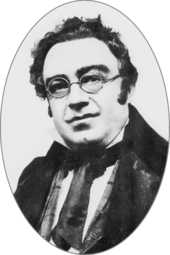Das Dreimäderlhaus
The work gives a fictionalized account of Schubert's romantic life, and the story was adapted from the 1912 novel Schwammerl by Rudolf Hans Bartsch (1873–1952).[3] Debuting during World War I, the operetta's popularity was fueled by the public's taste for nostalgia, harnessing an old-fashioned, sentimental story and Schubert's familiar music.[2] Das Dreimäderlhaus then premiered in Paris on May 7, 1921, in a French adaptation by Hugues Delorme and Léon Abric called Chanson d'amour (Song of Love).In London, the operetta was called Lilac Time, with an adapted libretto by Adrian Ross and music arranged by George H. Clutsam, using some of Berté's work.The Broadway production of Blossom Time opened at the Ambassador Theatre on September 29, 1921, where it ran for 592 performances, starring Bertram Peacock and Olga Cook.The plot follows the basic story of the original, but many significant details are changed, well-known Schubert pieces are gratuitously inserted and historically inaccurate material familiar to Americans of the era is added.Lilac Time opened at the Lyric Theatre on December 22, 1922, and ran for 626 performances,[11] The production was directed by Dion Boucicault; the musical director was Clarence Raybould.The tenor Richard Tauber played Schubert in several productions and tours of Das Dreimäderlhaus in Europe, first at Plauen, Germany, on 24 January 1920,[22] and then in five performances of the original version at the Theater an der Wien in October 1921 [Neue Freie Presse].He presented a new version of it in London in 1933, sung in German but with the English title Lilac Time, adapted by himself and Sylvio Mossée.[4] In 2005, UK label Classics for Pleasure, a branch of EMI, released on CD the 1959 HMV recording of Lilac Time[25]


Das Dreimäderlhaus (disambiguation)Franz SchubertAlfred Maria WillnerViennaBerlinBroadwayWest EndpasticheoperettaHeinrich BertéRudolf Hans BartschDie schöne MüllerinpasticcioRaimundtheaterFranz von SuppéWorld War ISigmund RombergDorothy DonnellyAmbassador TheatreAdrian RossGeorge H. ClutsamLyric TheatreBeethovenPraterShubert brothersThe Student PrinceJ. C. HuffmanCourtice PoundsDion BoucicaultClarence RaybouldBarbara GottRobert NainbyMoya NugentPercy HemingEdmund GwennJerrold RobertshawThe EraDaly's TheatreGlobe TheatreRichard TauberAldwych TheatreAlhambra TheatreLondon ColiseumStoll TheatreHis Majesty's TheatrePlauenTheater an der Wiena film versionJane BaxterAl GoodmanRCA VictorJune BronhillThomas RoundSadler's Wells OperaJésus EtcheverryAndré MallabreraLina DacharyFreda BettiReader's DigestOhio Light OperaWayback MachineGreen, StanleyThe Blue ParadiseThe Desert SongMaytimeMay WineMy MarylandThe New MoonThe Passing Show of 1916The Passing Show of 1918Princess FlaviaRobinson Crusoe, Jr.RosalieSinbadUp in Central ParkCompositionsBy genreSymphoniespiano soloSonatas, duos and fantasiesSongs and part-songssong cyclesStage worksArrangementsCopiesDoubtful and spuriousundatedDeutsch catalogueopus/Deutsch number concordance19th century complete editionNew Schubert EditionSchubertiadeSchubert at the Piano1928 International Columbia Graphophone CompetitionSchubert's Dream of SpringGently My Songs EntreatSerenadeThe Great AwakeningIt's Only LoveLa Belle MeunièreAngeli senza paradisoEva Badura-SkodaOtto Erich DeutschWalther DürrJulius EpsteinDietrich Fischer-DieskauMax FriedlaenderJohann Nepomuk FuchsTherese GrobErnst HilmarAnselm HüttenbrennerEusebius MandyczewskiJohann MayrhoferElizabeth Norman McKayGustav NottebohmWilhelm MüllerJohann Philipp NeumannBrian NewbouldAntonio SalieriFranz von SchoberFerdinand SchubertJohann SennJoseph von SpaunRita SteblinJohann Michael Vogl